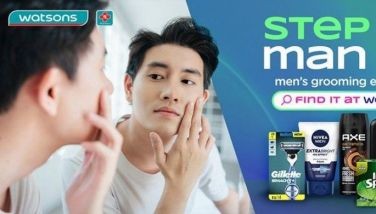Wet weather challenges
During the week-long habagat-induced torrential rains, I found myself as a front passenger in a government AUV. We had just finished a series of lectures at the Development Academy of the Philippines in Tagaytay City and were heading down to Manila through the pouring rain, made even more challenging by fog that hugged the road.
Our driver was quite elderly, wore glasses and squinted most of the time. He was obviously having a hard time with the weather plus the inconsiderate habit of oncoming drivers who used their “bright” lights until the last minute before switching to dim. What made matters worse was the fact that the AUV we were riding in had old wipers that should have been replaced at the beginning of the rainy season and the windshield of the vehicle had an accumulation of pollutants thereby creating a perpetual oil slick that reduced visibility even more.
Many drivers and car owners think that powder form laundry soap is “dry” enough to suck the film and wash it off. Others simply resign themselves to the thought that their windshields are old and therefore subject to such stains. Some people try using newspapers or cigarette tobacco to rub off the oily film but end up adding more slick due to the nicotine or ink from newspapers. As a last resort, they buy the biggest, thickest wipers they can get with out realizing that the additional weight and length will ultimately take its toll on the wiper motors.
The funny part is every time I recommend that they use the cheap regular rubbing compound that’s sold in paint stores and rub it on the windshield, they all look at me in shock as if I was intentionally trying to do harm to their windshield. I realize that common knowledge tells us that glass is subject to scratching and the last thing you want are scratches on your windshield.
But what many people don’t realize is that rubbing compound is used on paint, which is much softer and thinner than windshields. The compound is so fine that even with electric buffers, you would have to exert extreme effort in order to scratch up the windshield. What the rubbing compound does when applied with water is to rub off the oily film of accumulated pollutants on the windshield. Two minutes of elbow power, rubbing compound and a sprinkling of water to keep things wet will surely give you greater visibility especially with older model cars. Once you’re done, just wash it off with a little dishwashing soap.
* * *
If you use your windshield sprayer a lot, please bear in mind that the type of cleaning fluid you use will ultimately leave traces on your screen. Many people use powdered detergent soap but don’t realize that this tends to clog the tube and nozzles of the sprayers. This type of soap also tends to leave a nasty film once the windshield air or sun dries.
A good tip is to follow what scuba divers and snorkelers recommend. Use five to ten percent baby shampoo mixed with water. Baby shampoos tend to be residual free as long as you make sure they don’t have added moisturizers or fragrance. You are better of with a mild mix than overdosing on dish soaps or detergent.
* * *
While on the subject of windshields, I’m almost sure that some people are now paying the price for having a fully tinted windshield. The idea may have been great during summer, but when you find yourself in constant rain, fog and oncoming “bright” lights, you soon discover that a fully tinted windshield also results in diminished visibility.
If you happen to wear prescription glasses, particularly “progressive lenses” that allow you to read and view short and far distances with one lens, you may have already discovered that a fully tinted windshield distorts your vision because the progressive lens is responding to the “visual obstruction” or distortion created by the tint. I experienced this through a series of test drives and discovered the problem. After all the headache, I now refuse to drive such vehicles.
* * *
Because of the increased humidity brought by the rainy season, chances are your car or cars will ultimately display signs of mildew. This is dangerous for your health and should immediately be dealt with. Don’t just wipe the mildew off your seats and dashboard. Make sure to use some type of cleaning material for mildew to arrest the problem. As a quick fix I make a very mild mix of bleach in tap water or plain alcohol and I wipe off all the mildew.
Some people suggest placing lots of newspapers on the floor pans or charcoal to absorb the humidity. A trick I learned abroad is to hang a 25 or 50-watt light bulb somewhere in the middle of the car. The heat and light effectively dries up the interior and kills the mildew.
* * *
Sometimes, it’s just not worth driving through torrential rain especially flooded streets. A lot of drivers think that it’s ok to go through high waters as long as the water does not get into the car or drowns the engine. Yes many have survived for the moment but they ultimately cause enough damage without even knowing it.
The first casualty of such mindset is the car horn. People always forget that their car horns are not waterproof. Then follow the auxiliary fans. They might not die on the spot, but once they get dipped in water they will short out. Then come the fuel pump in sports cars or modified vehicles that have external high capacity electric fuel pumps. These are usually located in the belly of the vehicle right after the fuel tank. Dip them in water and they rust out at the connections or totally fail. Finally, please mind your headlights. I have seen so many headlights corrode or give out because water managed to get through the boot or seal. Check them once in a while and you will save yourself some money.
* * *
Final word of caution on wet-weather driving, PLEASE don’t drive with thin or bald tires, especially on the front wheels. This they say is equivalent to driving with one foot in the grave. If you think you’re saving money, just consider how much you will have to pay in damages or death compared to buying a new set of tires that will last you for about a year or so. Wet roads and bald tires equal loss of braking capacity and handling.
* * *
On a totally different subject, just in case you find yourself having difficulty finding the right shock absorbers for your not so common car, try out the people at Bilstein located at Wheel Gallery #318 Santolan Road corner Pasadena St. (tel nos. 477-8577 & 477-8628) I recently discovered that finding shocks for a Nissan Skyline was not the easiest or simplest task to do. Thank to Arvin Lim’s personal and professional assistance, we found the much needed shock absorbers and I am thoroughly enjoying the ride.
Stay safe, stay dry, and have fun.
- Latest






























